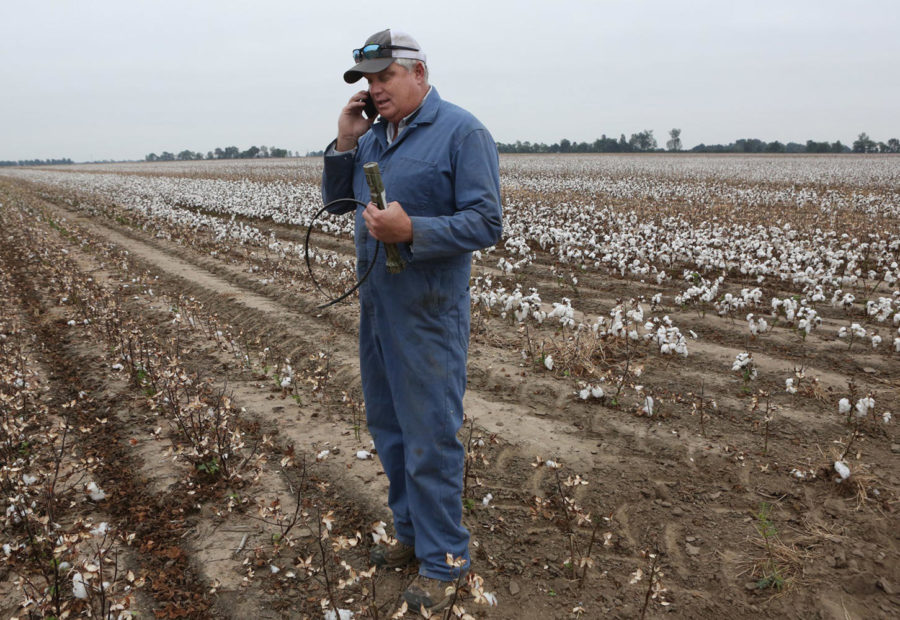Missouri farmers wrestle with toll of widespread dicamba damage
Farmer Jason Bean calls to locate a new belt for his cotton picker on Wednesday, Oct. 12, 2017, at his farm near Peach Orchard, Mo. Bean is busy harvesting his soybeans, rice, and cotton this month. The broken belt shut down his cotton picker for a short time until he got it replaced. The $49 belt is needed to keep the $800,000 cotton picker working. (J.B. Forbes/St. Louis Post-Dispatch/TNS)
October 19, 2017
It’s been a stressful growing season for Chris Crosskno — one characterized by the cupped and crinkled soybean leaves that were a common sight across millions of acres of the nation’s farmland this year.
“We had about 2,000 acres of Liberty soybeans and every one of ’em was damaged at some point,” says Crosskno, who farms deep in southeast Missouri’s Bootheel region and across the state line in Arkansas.
The distinctive symptoms point to exposure to dicamba, a decades-old chemical the agriculture industry is now turning to in the fight against increasingly stubborn “superweeds” — a controversial shift that has borne different results for different farmers and left the agriculture community divided.
Advertisement
Damage like that experienced by Crosskno has been widespread across the Farm Belt, causing conflicts between neighbors, recriminations and lawsuits, culminating with the Environmental Protection Agency announcing this month that increased regulatory oversight will be required for dicamba applications in 2018.
Sparking the controversy was a shift to new technology spearheaded by Monsanto, the seeds and traits giant that, for years, has counted the herbicide, Roundup, as its signature product. But with weeds developing resistance to Roundup, dicamba has begun to emerge as a successor over the last couple years, as the company, headquartered in suburban St. Louis, introduced new cotton and soybean varieties genetically modified to tolerate the chemical, enabling farmers to spray it over the top of those crops.
The new dicamba system — fully available for the first time this growing season — is hailed by many farmers in the Bootheel as a critical tool that has helped facilitate record yields and some of the “cleanest” or least weed-afflicted crops since Roundup-resistant seed varieties first came out in the 1990s.
But others, like Crosskno, have not shared the abundance enabled by the technology, and have perhaps even been hurt by it.
Though an effective weedkiller, dicamba is a notoriously volatile chemical, meaning it is prone to turning into vapor that can drift off target. Soybeans are particularly sensitive to dicamba damage, but many types of non-tolerant plants — including trees and garden vegetables — can also be susceptible to injury.
The dicamba varieties approved for use on Monsanto’s dicamba-tolerant Xtend crops this growing season were less volatile than older forms of the chemical, but as the acreage sprayed with the herbicide rose across the country this year, so too did reports of damage caused by off-target movement.
With the harvest ongoing, the impact that damage could have on Crosskno’s yields is still coming into focus. But he worries that, like some of his neighbors are reporting, he could lose 8 to 10 bushels of his LibertyLink soybeans per acre — a loss that would amount to $180,000 or so.
Advertisement*
To avoid future losses, Crosskno says he’ll have no choice but to switch, begrudgingly, to Monsanto’s dicamba-tolerant seed next year, sparing himself the stress he’s endured this season.
“You either get on board or get hurt,” he said. “I absolutely hate it. I despise the idea that Monsanto can dictate what we have to use, have to plant.”
___
(c)2017 St. Louis Post-Dispatch
Visit the St. Louis Post-Dispatch at www.stltoday.com
Distributed by Tribune Content Agency, LLC.
Advertisement










